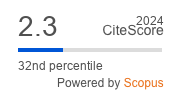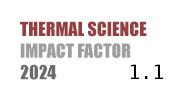THERMAL SCIENCE
International Scientific Journal
SYNERGISTIC EFFECT ON COMBUSTION KINETICS AND ASH FUSION CHARACTERISTICS DURING CO-COMBUSTION OF BITUMINOUS COAL AND WHEAT STRAW
ABSTRACT
In this study, the combustion behavior, synergistic effect and ash characteristics during the co-combustion of bituminous coal and wheat straw were fully analyzed by thermogravimetric analyzer, ash melting point analyzer, X-ray diffraction, and SEM. Thermogravimetry analysis showed that wheat straw was easier to be ignited, showing higher devolatilization activity and lower thermopositive temperature. Co-combustion displayed volatiles and char combustion stage and showed lower combustion rate compared to mono-combustion. For the wheat straw blending ratio ≤ 50%, significant positive synergistic effect was observed during the volatiles combustion stage while negative synergistic effect was found during the char combustion stage. With wheat straw blending, the co-combustion ash fusion temperature first increased and then decreased. The mineral components of co-combustion ash gradually changed from high ash melting point compounds to complex calcium silicate hydrate. The morphology of co-combustion ash turned from hard flake structure to loose porous structure, showing partial melting in the biomass derived pores. Small addition of wheat straw during co-combustion would be beneficial to enhance the ash fusion temperature and optimize combustion performance.
KEYWORDS
PAPER SUBMITTED: 2025-03-14
PAPER REVISED: 2025-06-18
PAPER ACCEPTED: 2025-06-19
PUBLISHED ONLINE: 2025-08-02
THERMAL SCIENCE YEAR
2025, VOLUME
29, ISSUE
Issue 5, PAGES [3615 - 3628]
- Deonarine, A., et al., Environmental Impacts of Coal Combustion Residuals: Current Understanding and Future Perspectives, Environmental Science & Technology, 57 (2023), 5, pp. 1855-1869
- Antar, M., et al., Biomass for a Sustainable Bioeconomy: An Overview of World Biomass Production and Utilization, Renewable and Sustainable Energy Reviews, 139 (2021), 110691
- Mureddu, M., et al., Air-and Oxygen-Blown Characterization of Coal And Biomass by Thermogravimetric Analysis, Fuel, 212 (2018), Jan., pp. 626-637
- Moon, C., et al., Effect of Blending Ratio on Combustion Performance in Blends of Biomass and Coals of Different Ranks, Experimental Thermal and Fluid Science, 47 (2013), May, pp. 232-240
- Jayaraman, K., et al., Thermogravimetric and Mass Spectrometric (TG-MS) Analysis and Kinetics of Coal-Biomass Blends, Renewable Energy, 101 (2017), Feb., pp. 293-300
- Oladejo, J. M., et al., In-Situ Monitoring of the Transformation of Ash Upon Heating and the Prediction of Ash Fusion Behaviour of Coal/Biomass Blends, Energy, 199 (2020), 117330
- Zhang, L., et al., Influence of Biomass Ash Additive on Fusion Characteristics of High-Silicon-Aluminum Coal Ash, Fuel, 282 (2020), 118876
- Unchaisri, T., Fukuda, S., Investigation of Ash Formation and Deposit Characteristics in CFB Co-Combustion of Coal with Various Biomass Fuels, Journal of the Energy Institute, 105 (2022), Dec., pp. 42-52
- Taghizadeh-Alisaraei, A., et al., Potential of Biofuels Production from Wheat Straw Biomass, Current Achievements and Perspectives: A Review, Biofuels, 14 (2023), 1, pp. 79-92
- Chaudhuri, P., et al., Unravelling Bioenergy Potential of Bamboo and Bamboo Biochar through Thermogravimetric Analysis, Energy Sources - Part A: Recovery, Utilization, and Environmental Effects, 47 (2025), 1, pp. 10601-10612
- Milićević, A., et al., Mathematical Modelling and Optimisation of Lignite and Wheat Straw Co-Combustion in 350 MWe Boiler Furnace, Applied Energy, 260 (2020), 114206
- Wang, Q., et al., Reactivity and Kinetic Analysis of Biomass during Combustion, Energy Procedia, 17 (2012), Part A, pp. 869-875
- Tong, W., et al., Experiment and Expectation: Co-Combustion Behavior of Anthracite and Biomass Char, Bioresource Technology, 280 (2019), May, pp. 412-420
- Zhu, L., Zhong, Z., Effects of Cellulose, Hemicellulose and Lignin on Biomass Pyrolysis Kinetics, Korean Journal of Chemical Engineering, 37 (2020), 10, pp. 1660-1668
- Caliskan Sarikaya, A., et al., Synergistic Interactions During Cocombustion of Lignite, Biomass, and Their Chars, Journal of Energy Resources Technology, 141 (2019), 12, 122203
- Kastanaki, E., Vamvuka, D., A Comparative Reactivity and Kinetic Study on the Combustion of Coal-Biomass Char Blends, Fuel, 85 (2006), 9, pp. 1186-1193
- Cong, H., et al., Evaluating the Performance of Honeycomb Briquettes Produced from Semi-Coke and Corn Stover Char: Co-Combustion, Emission Characteristics, and A Value-Chain Model for Rural China, Journal of Cleaner Production, 244 (2020), 118770
- He, Z.-M., et al., Review of Biomass Agglomeration for Fluidized-Bed Gasification or Combustion Processes with a Focus on the Effect of Alkali Salts, Energy & Fuels, 36 (2022), 16, pp. 8925-8947
- Yang, G., et al., Co-Melting Properties and Mineral Transformation Behavior of Mixtures by MSWI Fly Ash and Coal Ash, Journal of the Energy Institute, 96 (2021), June, pp. 148-157
- Che Pa, F., Mohamad Nasir, N. N., Synthesis of Zeolite from Rice Husk Ash, Proceedings, The Green Materials and Electronic Packaging Interconnect Technology Symposium, Springer Nature Singapore, Singapore, 2023
- Deng, S., et al., Ash Fusion Characteristics and Mineral Matter Transformations during Sewage Sludge/Petrochemical Sludge Co-Firing with Wheat Straw, Journal of Cleaner Production, 260 (2020) 121103
- Wang, T., et al., Regulation of Ash Slagging Behavior for Sewage Sludge by Rice Husk Addition: Focusing on Control Mechanisms, Journal of Cleaner Production, 284 (2021), 124677
- Lu, Y., et al., Investigation on the Ash Characteristics and AAEM Migration During Co-Combustion of Zhundong Coal and Shale Char in a Fixed Bed, Fuel, 327 (2022), 125214
- Xiao, H., et al., Effect of Potassium-Containing Sulfates on High-Temperature Mineral Transformation and Coal Ash Fusibility, Energy Sources - Part A: Recovery, Utilization, Environmental Effects, 46 (2024), 1, pp. 12496-12511

